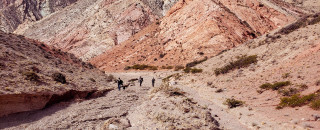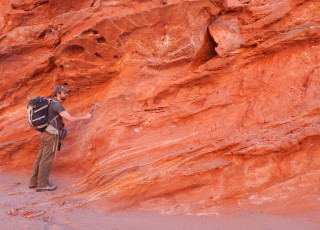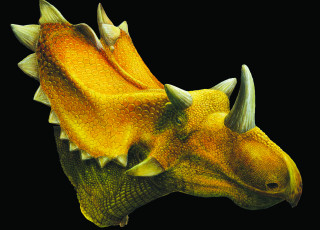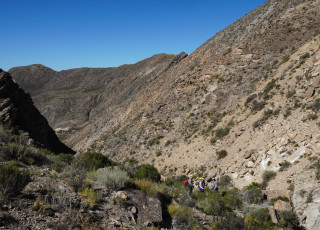Mapping the Past: A Quest for Answers in the Triassic Period
By Cosette Reeves
Upon returning from his year-long sabbatical, Randy Irmis, Ph.D., NHMU’s Curator of Paleontology, was brimming with excitement as he shared his findings from the field. His ongoing research into the Triassic Period, set against Argentina’s fossil-rich landscape, is deepening the complexity of our understanding of this pivotal era in Earth’s history. With each new find, the broader puzzle expands, revealing even more questions that fuel his quest for answers.
The early age of dinosaurs—the Triassic Period—remains a favorite of Irmis. Spanning from 252–201 million years ago and framed by two climate-change-driven mass extinction events, this was an exciting era and may even offer key insights into today’s shifting climate. But despite its role in shaping life on Earth as we know it, much of this period remains shrouded in mystery. Paleontologists continue to unearth fossils, date geological formations, and cast their findings into a comprehensive paleoclimate record to help us better understand this time. Yet, with each discovery, the questions only grow more intriguing.
Irmis has been collaborating with colleagues in Argentina—a country renowned for its exceptional Triassic fossil record (including housing fossils of the earliest known dinosaurs!)—since he first travelled there in 2005 for a museum collections visit. After earning his PhD on the origin of dinosaurs, he began working in Argentina regularly, visiting nearly every year since 2010 to conduct fieldwork with his Argentine colleagues. Although he greatly enjoys these trips, time is limited, and he is allowed only a few days out in the field and lab before he needs to return back to the States. Now, thanks to his sabbatical and Fulbright Fellowship, Irmis was able to continue his work in Argentina for six months, hosted by the Instituto Argentino de Nivología Glaciología y Ciencias Ambientales (IANIGLA) in Mendoza.
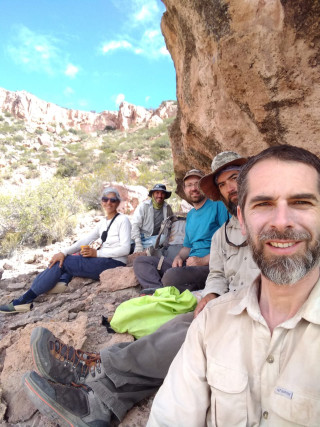
Randy Irmis, Ph.D., and his colleagues in Argentina would take regular breaks out in the field to energize themselves with mate, a traditional South American caffeine-rich tea, before continuing their trek through the Triassic rocks of southern Mendoza Province. Photo courtesy of Randy Irmis.
After spending the first six months of his sabbatical in Fall 2023 in southern Utah focusing on his research from an earlier time predating the Triassic—the late Paleozoic Ice Age—Irmis set out to devote the remainder of his sabbatical to his Triassic work in Argentina. There, he continued his long-term research on building a comprehensive paleontological and paleoenvironmental dataset covering the entire Triassic sequence in the region. His goal is to achieve a greater understanding of how these ecosystems evolved throughout the Triassic Period, and he and his colleagues made significant progress in their efforts.
In pursuit of this goal, a highlight for Irmis was the opportunity to conduct fieldwork for the first time in an area of southern Mendoza Province known for its high concentration of mammal ancestor fossils from the Middle Triassic Period. These fossils bear striking similarities to those found in Africa, raising an important question: do the geological formations also share similarities in age? If they do, this suggests these species were widespread, pointing to a cosmopolitan fauna across much of the southern hemisphere of Pangaea. If they do not, it indicates the evolution of these two ecosystems followed different paths after the end-Permian mass extinction, presenting a more nuanced narrative.
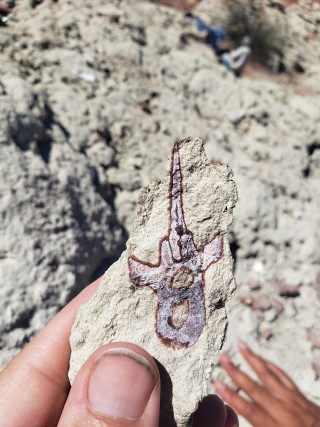
The fossil shown here is a vertebra cross-section of a newly discovered cynodont (early mammal relative) from Triassic rocks in southern Mendoza Province, Argentina. This species is very closely related to cynodonts found in South Africa, Namibia, and Tanzania. Photo courtesy of Randy Irmis
It has been proposed, after this extinction event marked the beginning of the Triassic Period, ecosystems initially appeared similar but evolved in distinct ways as they recovered. However, the more differences we observe throughout this time period, the more complex our interpretation of how ecosystems respond and recover becomes. Irmis looks forward to exploring this further, not only by uncovering more fossils but also by collaborating with colleagues to provide more precise absolute dates for the fossil assemblages, revealing a broader story of how these ecosystems changed over time.
“Every new fossil we find is a data point… and we always need more data to answer these types of questions,” Irmis stated, highlighting the significance and thrill of each newly excavated fossil and observation. He further emphasized the value of ongoing data collection after having to significantly revise the geologic ages for the formations he’s been studying in southern La Rioja and northern Mendoza provinces for quite some time. As Irmis learned firsthand—just as a single soccer game in Mendoza can reroute an entire bus system and leave you stranded—a single new data point can completely reshape our understanding of a region’s history.
Irmis will be spending the next several months working towards publishing his results from his time on sabbatical and applying for further funding to continue his hunt for more riveting questions—and hopefully some alluring answers.
Learn more about research being conducted by NHMU's paleontologists in the Past Worlds exhibition or at DinoFest in January.
